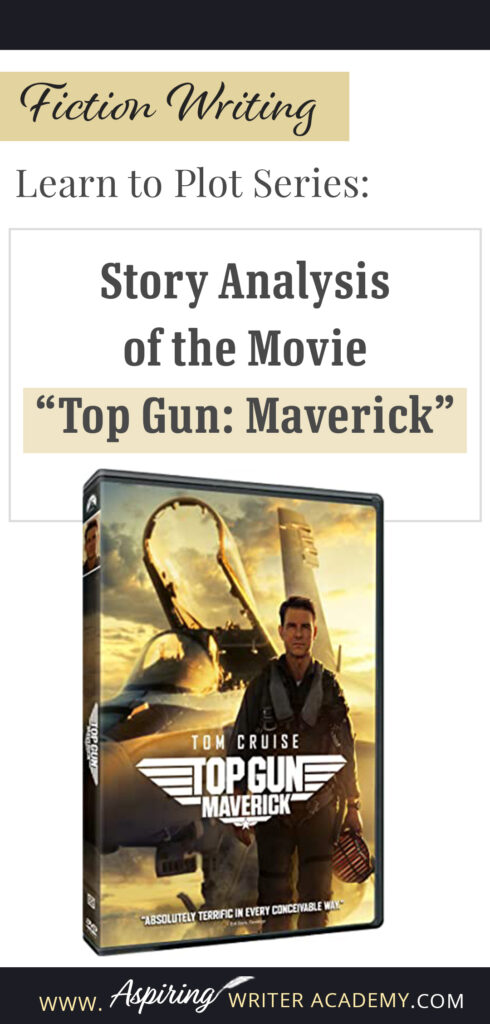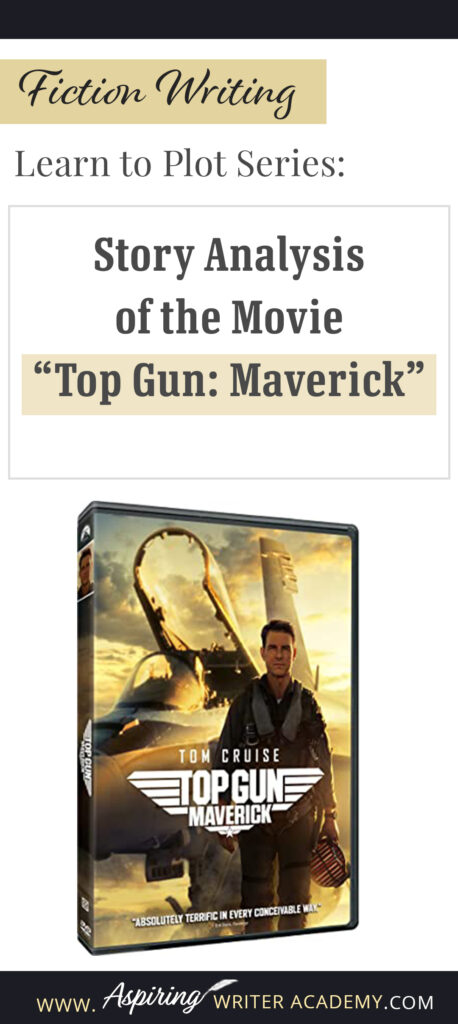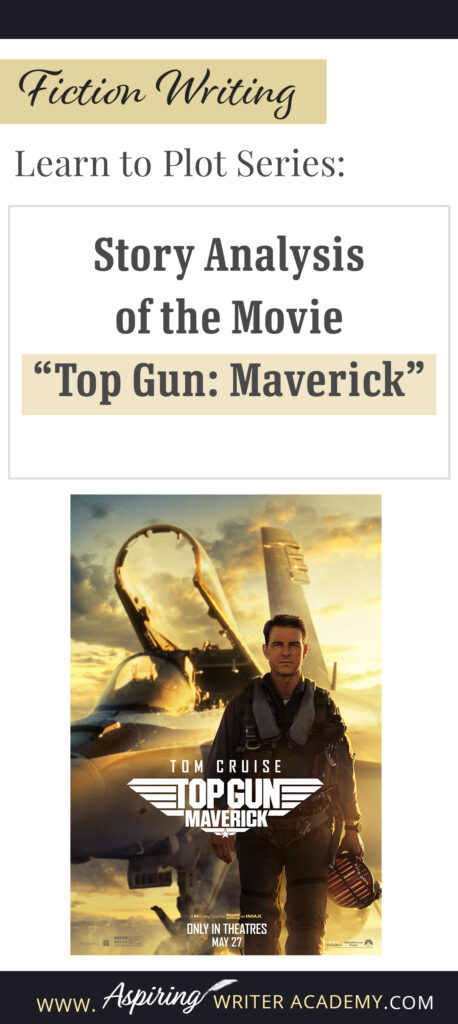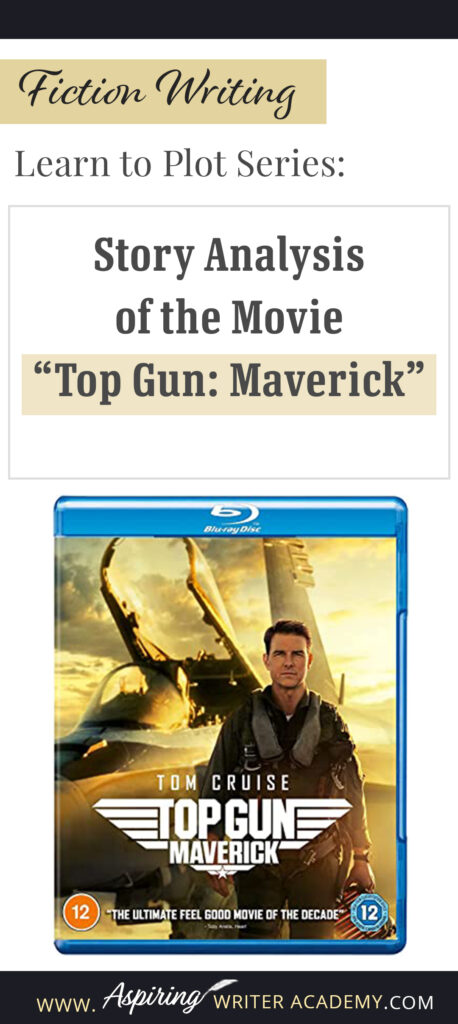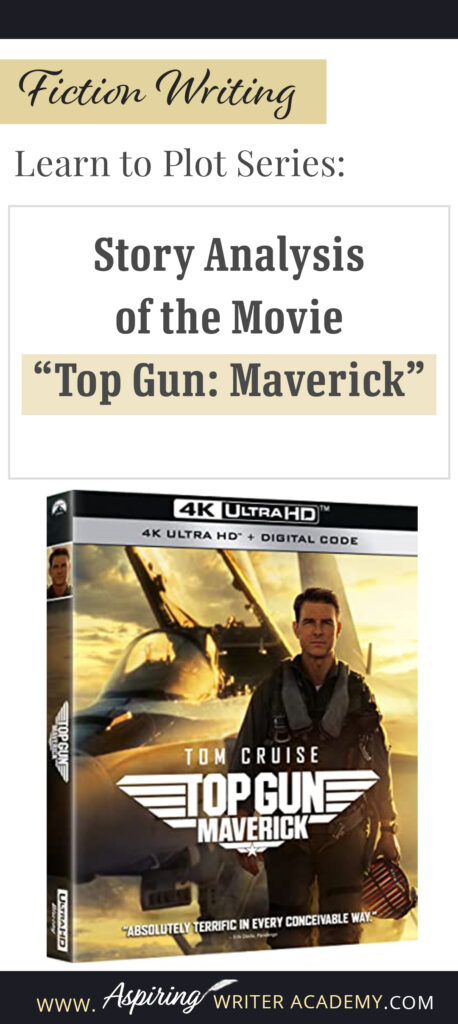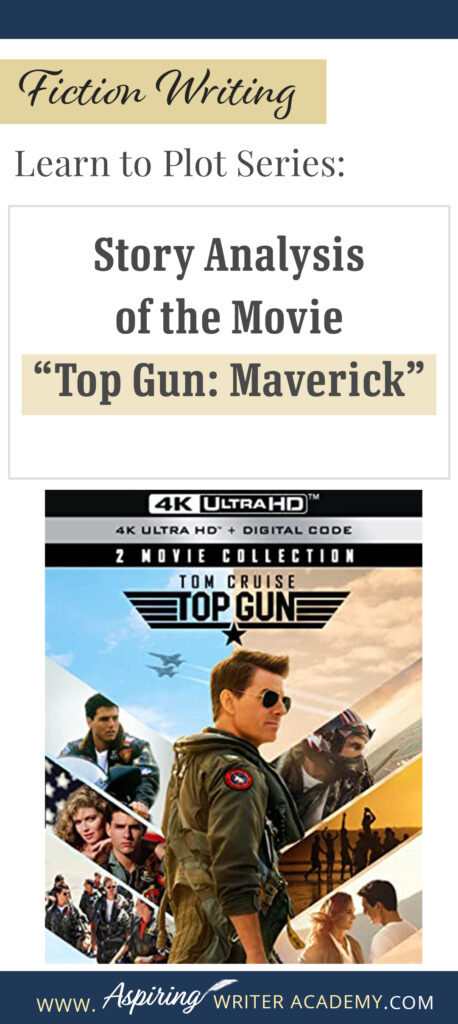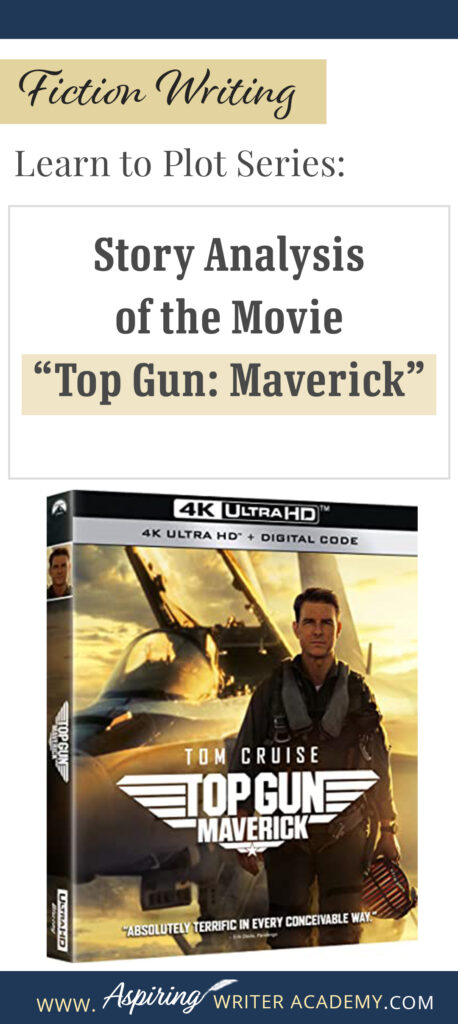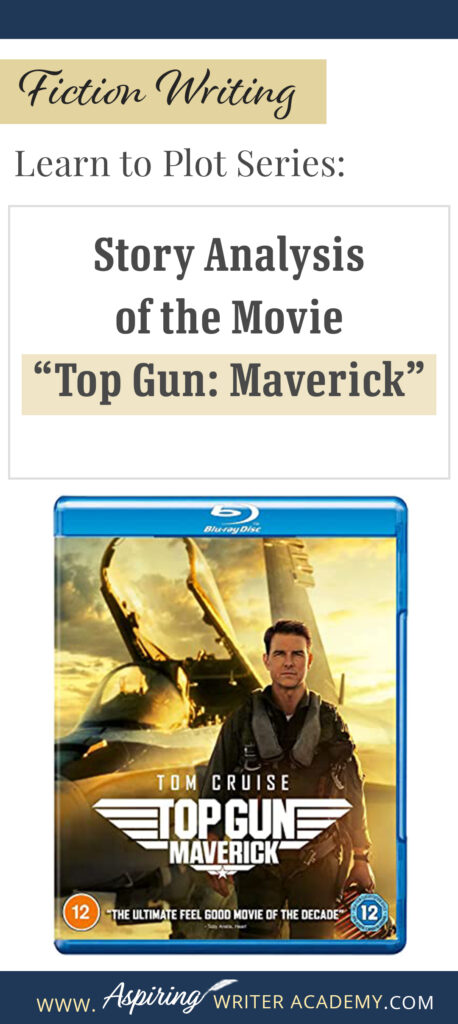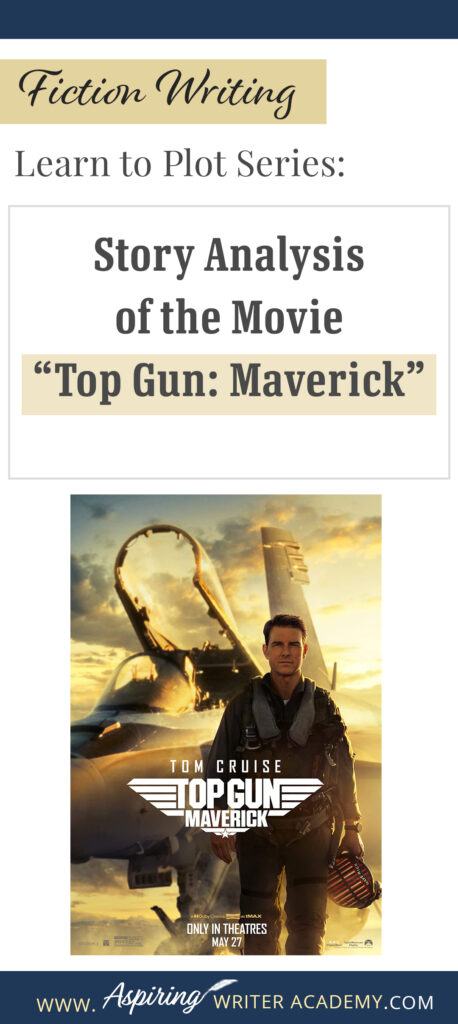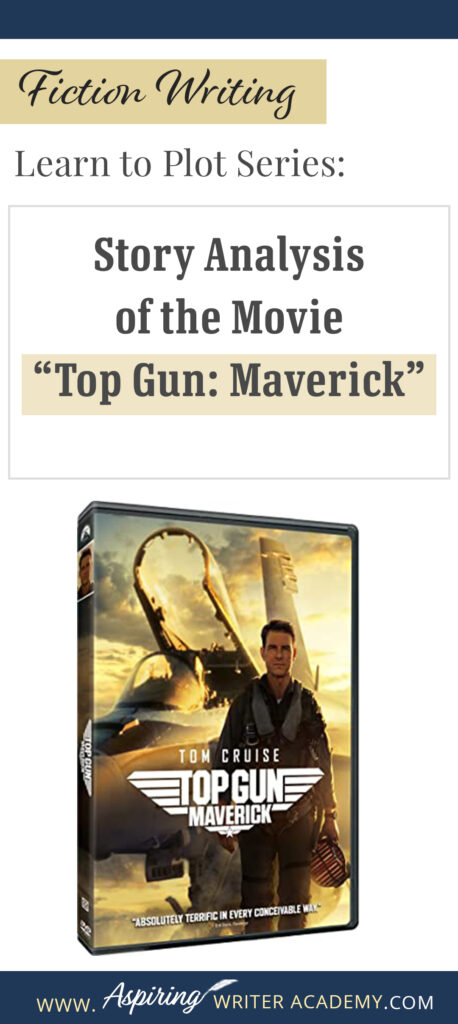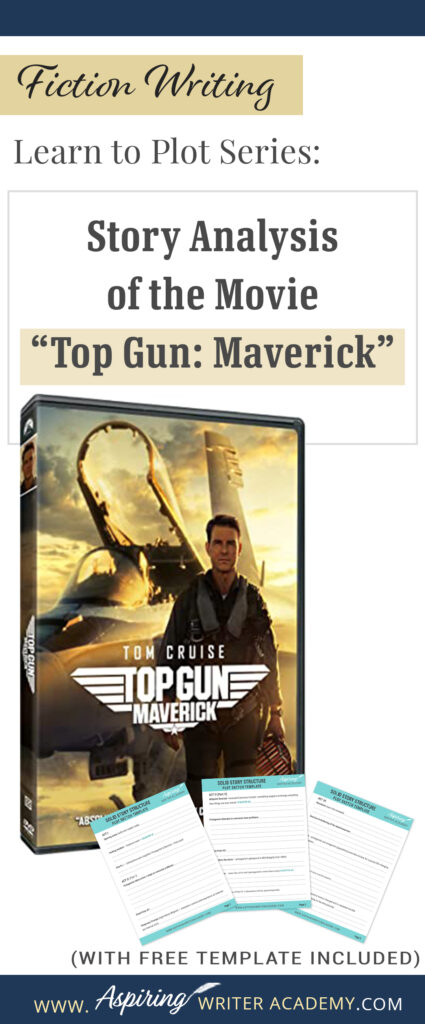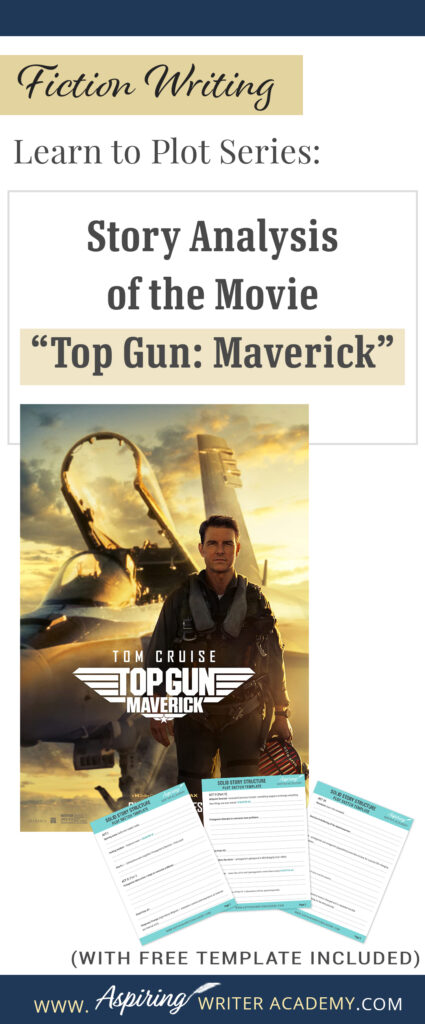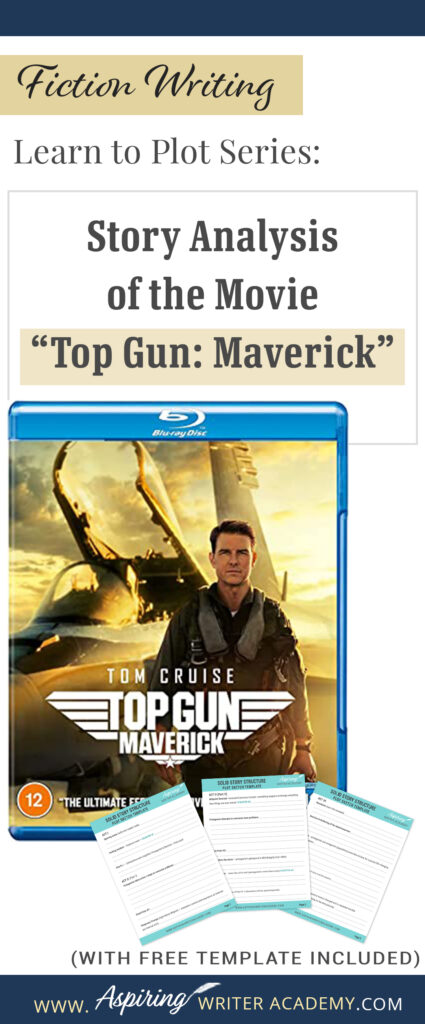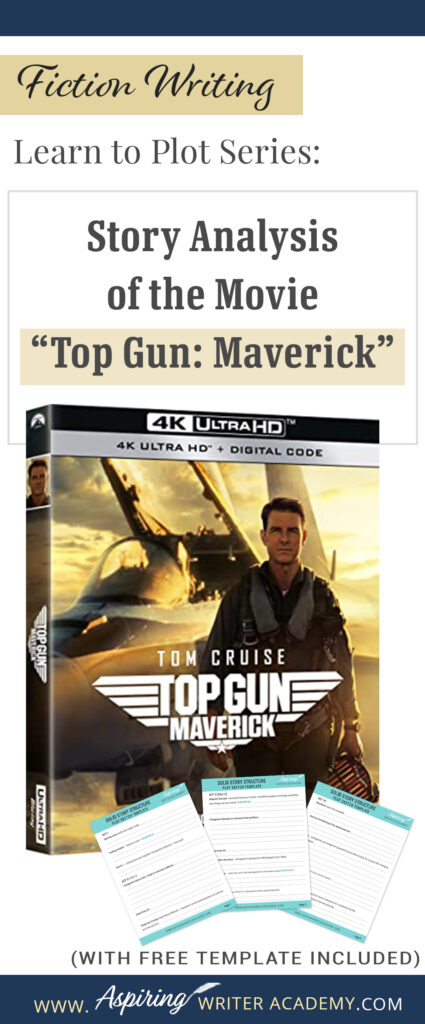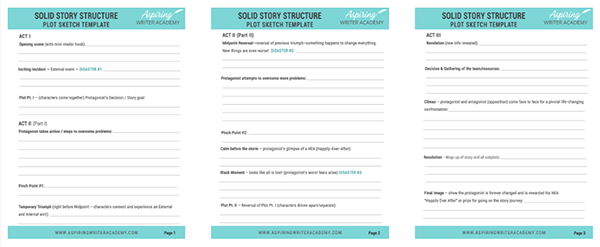Learn To Plot Fiction Writing Series: Story Analysis of the Movie “Top Gun: Maverick”
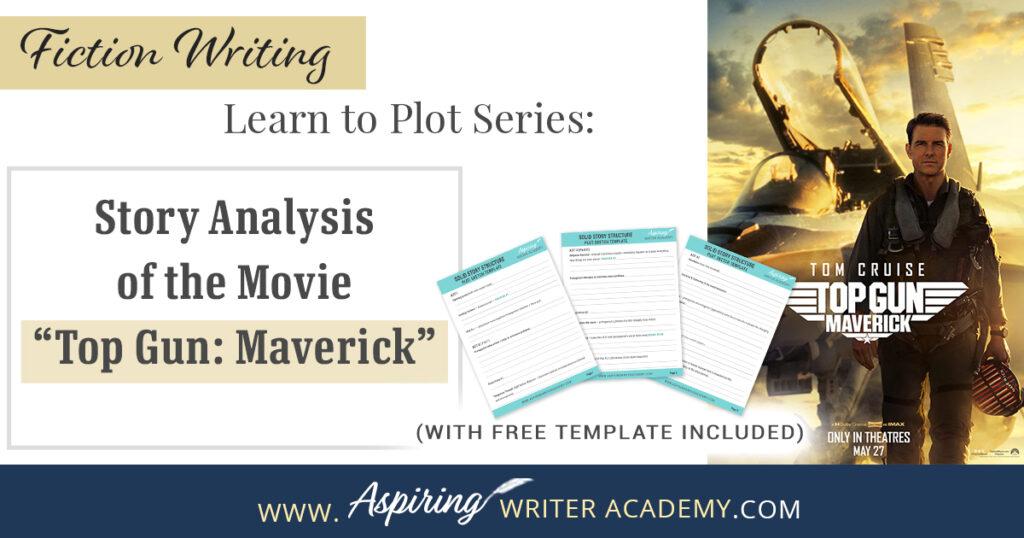
The best way to learn story structure is to analyze good stories. Can you readily identify each plot point in every movie you see or book you read? Or do terms like ‘inciting incident,’ ‘midpoint reversal,’ and ‘black moment’ leave you confused?
In our Learn to Plot Fiction Writing Series: Story Analysis of the movie “Top Gun: Maverick” we will show you how to recognize each element and provide you with a Free Plot Template so you can draft satisfying, high-quality stories of your own.
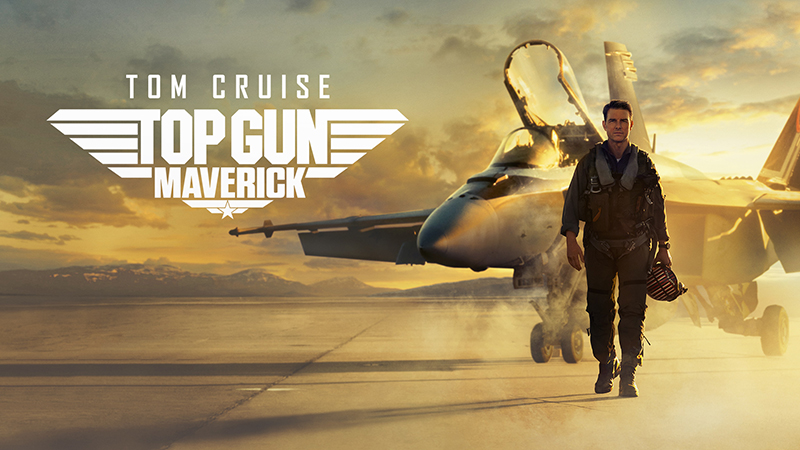
Promotional Poster for “Top Gun: Maverick” by Paramount Pictures
Official Paramount Pictures Movie Blurb:
After more than thirty years of service as a top naval aviator, Pete “Maverick” Mitchell (Tom Cruise) is where he belongs, pushing the envelope as a courageous test pilot. Yet, Maverick must confront the ghosts of his past when he returns to TOPGUN to train a group of elite graduates and comes face to face with Lt. Bradshaw (Miles Teller), the son of his former wingman "Goose". Bitter rivalries ignite as the pilots prepare for a specialized mission which will require the ultimate sacrifice from those chosen to fly it.
The movie was released October 2022 and stars Tom Cruise and Jennifer Connelly.
Watch Now on Amazon: https://amzn.to/3HiL0bm
One of the best ways to learn story structure is to analyze as many movies and books as you can. We suggest you watch movies because you can see the whole story played out before you visually in approximately two hours, which may be quicker than reading an entire book.
We also suggest that you watch the movie with our Free Downloadable Solid Story Structure Plot Template beside you so that you can write down each plot point as soon as you see it appear on the screen. Do this twenty or so more times and you will soon be on your way to becoming a story structure expert!
Click to download our free Solid Story Structure Plot Sketch Template to help you analyze books or movies, and plot stories of your very own.
Warning! This post contains story spoilers. If you have not already seen the movie and do not want any story spoilers the first time around, you might want to watch the movie for enjoyment then watch it a second time using this post to help you identify each story element.
ACT I
Opening Scenes:
What do the opening scenes of “Top Gun: Maverick” accomplish? How do they serve to set up the story?
- Setting.
First, you need to establish the ‘ordinary world.’ When the movie opens, we see a scene sequence featuring fighter pilots who are practicing take-offs and landings upon a naval aircraft carrier. We immediately see that this story will focus on characters who are in the U.S. military.
- First scene opens with an interesting situation (initial problem).
The story opens with the characters facing an initial problem, which acts as a hook, to grab the reader’s attention. This isn’t the main problem yet, but a situation or event to get the story rolling. It is a scene that will tie into the major problem later.
In Top Gun: Maverick we learn that the protagonist, Pete “Maverick” Mitchell has been helping his team test a new jet, trying to push the speed to Mach 10. So far, the team has not been able to achieve this speed and they are informed their program will lose funding and close down this very day. In fact, their superior is on their way over to make it official. Unless… they get the jet up in the air and try one last time to reach Mach 10.
- Introduction of the main characters, their personalities, and the character’s relationships with one another. Also hint at the internal (relationship) conflict and escalating external conflict.
- One of the first scenes shows the main character, Maverick, content with his life and fixing a plane inside a U.S. Navy hanger. Above his work desk, there are many photos of him and his best friend/wingman “Goose” from long ago. His friend had died during a mission gone wrong while they were flying together. There is also a photo of Goose with his family, a wife and young son. This wall shows that these people are important to Maverick and foreshadows they may have something to do with the present story.
- When presented with the initial problem, we first see that Maverick is well liked and admired by the team he works with and cares about saving their jobs. (Admirable traits).
- Next, we also see that he is also bold and reckless for his willingness to go against orders and try to prove the jet can reach Mach 10 before their superior gets there. (His weakness/negative character flaws). Not only could he get in huge trouble, but he risks his life and the preservation of the high-dollar fighter jet he is flying.
- Maverick proves he is a rule-breaker used to pushing the limit when he confounds the superior by not only making Mach 10 but he pushes the jet even further to set a new record. Maverick’s team groans, sweating it out as he does this, and we instantly know this is a character flaw that is bound to trip Maverick up again and again. Maverick sets up his special ability as the only one who can break Mach 10. And he saves and inspires his team by proving their program is worthy, that they can do it. This is foreshadowing for what will happen again toward the end of the story. (Notice that the flip side of his strength is also his weakness.)
- However, the jet can only take so much, and crash lands in the desert. Although the superior would love to kick Maverick out of the military altogether for his actions, he must send Maverick back to the Top Gun naval air academy base (where Maverick first started out). A place known for ‘training the best of the best.’ This transfer was requested by an admiral, a rival turned friend whom Maverick knows as “Ice Man,” a fighter jet pilot who flew with him and Goose thirty years before.
- In the beginning of the original movie, Maverick had also pulled a stunt in a fighter jet that could have landed him in trouble, but his superior was forced to send him to Top Gun to train. Although it is a different set of circumstances, the similarities serve to tie the sequel to the original film and make the reader/viewer smile because this reinforces Maverick’s personality. This is who he is.
- We also learn that by now, Maverick should also be a high-ranking official with all his glowing credentials, but because of his disobedient antics, he remains a mere Captain. Although this does not appear to bother Maverick in the least, we see he is a highly qualified fighter pilot. (Worthy to pursue the upcoming challenge ahead.)
Note: All of these ‘details’ are set up pieces that will show up again later and impact the story. Everything your character needs at the end should be set up in the beginning so it is believable for the reader/viewer.
Ask—who are these characters and what will they need?
Inciting Incident:
After the opening scenes have introduced the characters and set up the genre, time period, location, hinted theme, and general pacing of the story, the protagonist is hit with the inciting incident, which rocks his (or her) ‘ordinary world’ and turns his life upside down. This serious problem cannot be ignored.
The protagonist must now decide how to deal with this serious problem, which becomes his new focus for the remainder of the story. The action plan to overcome this serious problem becomes the protagonist’s story-worthy goal.
- In the movie, Top Gun: Maverick, the Inciting Incident occurs when Maverick meets with the top heads of the Top Gun Naval Air Academy (who make it clear that they do not like him or approve of him being called in). Maverick is given the specifics for a special team mission to fly into enemy territory and take out an uranium target within three weeks. (3 weeks sets up the ticking clock to ramp up the tension with an approaching deadline to fulfill the mission.)
- It is a dangerous mission, with steep ascents. Four jets, flying in pairs, will have to deep dive into a valley, then shoot straight up over the top of the mountain peaks and dog fight all the way home. The top heads also make it clear that this will be Maverick’s last assignment. Maverick accepts the mission, but to his surprise, the officials do not want him to fly in the mission but be an instructor who teaches others to pull off the mission. And one of the fighter jet candidates is Goose’s son, Bradley, also known as “Rooster.”
-This makes the Inciting Incident personal. We learn that in the past, Maverick pulled Roosters papers, blocking his application to the navel academy. Maverick did this at the request of Rooster’s dying mother and because he did not think the boy was ready. Rooster is angry with Maverick for setting him back 4 years.
- The stakes for the story are set: Maverick knows that none of these elite young fighter jet pilots are ready for this mission and he fears for Rooster’s life. Everything Maverick has ever done was to protect him, and he fears losing Rooster like he lost Goose. Maverick can not let go of the past. (This sets up his character arc of what he will have to do – how he will have to change throughout the course of the story.) He needs to come to a point where he will trust Rooster to make his own choices.
Note: The inciting incident is also referred to as the first major turning point to turn the story in a different direction or Disaster #1. What happens at the inciting incident is a game-changer.
If you are not familiar with the elements of solid story structure for popular fiction, you may want to see our post, How to Plot Your Fictional Novel, to help you further understand the specifics of what should be included in each section.
Click To See Our Blog Post: How to Plot Your Fictional Novel
Plot Point I:
Plot Point I is the agreement between characters or decision the main character makes to accomplish a new story-worthy goal triggered by or in response to the inciting incident. This decision ends Act I. The main characters will unite to overcome the Inciting Incident problem.
- Maverick accepts the role of instructor to train these young fighter pilots, including Rooster, for the mission. He really has no choice. If Maverick doesn’t teach these pilots, someone less qualified will end up teaching them and the young pilots, including Rooster, might not make it. Maverick will now need to take steps to teach them so that they may be prepared and survive.
- This is Maverick’s new story-worthy goal, which also sets up the story question: Will Maverick be able to train these young fighter pilots to complete this dangerous mission and survive?
The audience is hooked and will continue watching/reading until the end of the story when this question is answered.
ACT II (Part I)
Now we journey into the main body of the story where the characters are learning to navigate their new ‘world/situation.’
- The secondary romance plot thread starts here. Maverick goes into the local bar by Top Gun and reconnects with his ex-girlfriend, Penny, in a humorous cute-meet scene. We learn that in the past she did not think he was reliable, and he has a reputation for leaving and dating lots of girls and getting in trouble in one way or another. Relationship conflict: Penny needs a guy she can depend on, one who will stay. Penny playfully gets revenge on him by setting him up to pay for everyone’s drinks (according to the rules of her bar – she’s the owner). When he doesn’t have the money, the young fighter pilots in the bar toss him out on the sand (not knowing who he is) and call him an ‘old man.’
- Introduction to all the main young fighter pilots who Maverick will be teaching. Only a handful of them will be selected for the actual mission and only one will be named mission leader.
- Rooster finds a rival in “Hangman.” The rivalry between Rooster and Hangman mirrors the same rivalry Maverick once had with the Admiral / Ice Man. We wonder if this second set will ever work out their differences and become friends like the first set. This also ties the sequel to the original movie.
- Each of the fighter jet pilots’ personalities and relationships with each other are established. Hangman mocks Rooster’s weakness of always being last, in the back while flying, always behind. Basically, he is mocking Rooster’s ability. Rooster needs to overcome this weakness if he is to succeed which sets up his character arc.
- Maverick looks at Rooster through the window (outside looking in) and sees Rooster playing the piano, the same song his father Goose had played in the old days, and it brings up painful memories. This reinforces Maverick’s weakness of still being hung up on his friend’s death – it haunts him – and he fears for Rooster.
The characters are learning, growing, being tested in their skills and in their relationship with one another. They are acquiring the know-how to face and deal with what is to come during the later segments of the story.
Themes start to emerge.
- When Hangman is introduced, someone says, “Looking good!” He responds, “I am good. I’m very good.” This sets up his egotistical personality but also comes around is repeated at the end of the movie, adding humor.
- When Maverick meets Penny, he also says she looks good and throughout the story she teases him, “Don’t look at me like that.”
- In the story opening someone tells Maverick that he doesn’t like that look on his face and Maverick responds that it’s the only look he’s got. This same line is repeated toward the end of the story, right before the climax.
- Top Gun is a facility for “the best of the best.” You’ve got to be skilled – good.
- So themes of looking good and being good run throughout the entire story. Both Maverick and Rooster have to try to prove they are good enough, that they have what it takes to succeed.
- These references all relate to the main theme of the movie: humanity vs. technology. Maverick tells Rooster that to succeed, “It’s not the plane, it’s the pilot.” Humans can use instincts to react in situations where technology’s capabilities are limited.
- There are also themes of having to let go of the past, forgiveness, trust, and belief in oneself.
Escalating events:
- When Maverick is introduced as the fighter pilot’s instructor, they all feel foolish for how they treated him at the bar the night before. But Maverick still has to out-fly and out-wit each of them to gain their trust and respect. This is his first task to achieve his goal.
- We see the conflict escalate between Maverick and Rooster as they push each other to the limits. Rooster is trying to prove himself, but Maverick keeps beating him in everything.
- Maverick is reacquainted with Penny’s teenage daughter who informs him her mother is no longer married, and when Penny and Maverick go sailing, they start to fall in love again.
- When the fighter pilots, led by Hangman, find out Maverick used to fly with Rooster’s dad, a fight breaks out and emotional tensions flare.
Pinch Point #1:
This emotional moment usually occurs about midway through the first half of Act II.
- The first pinch point serves to remind the main protagonist all he could lose if he doesn’t attain his goal (of training the young pilots to fly the mission.) Pinch Point #1 also motivates him to continue forward with renewed resolve. He will not give up!
- The first pinch point in Top Gun: Maverick is when Maverick goes to see the admiral / Ice Man and finds his friend is dying of cancer. He tells Ice Man that Rooster is still mad at him for delaying his application to be a pilot. Maverick says he didn’t think the boy was ready then, doesn’t know if he is ready now. Ice Man says teach him. Maverick says he doesn’t want to send the boy on the mission to die. Maverick says it would be better if he himself went.
- This is a highly emotional moment where Maverick faces the past and fears what he could lose.
- Ice Man tells him that it’s time to let go. Maverick responds that he doesn’t know how. He feels that he is not a teacher, he’s a fighter pilot. It’s who he is. Maverick is between a rock and a hard place (great conflict!) because if he sends Rooster on the mission the kid might never come home, but if he does not send him, Rooster will never forgive him, never see him again. Either way, Maverick fears he will lose him. And he has tried so hard to be a father figure to him.
- Ice Man says the kid needs Maverick, the navy needs Maverick. Maverick responds – that is why he was still here. (Reinforcing his motivation to achieve his goal.)
Temporary Triumph:
In most stories the characters experience an unexpected win in the external plot thread that triggers a celebratory win or triumph between the characters in the internal plot thread. In a romance, this is where the characters may share some backstory and kiss. It looks like the characters may be able to achieve their goal and will get their happily-ever-after. This is a moment of hope, that yes, the character can win.
- After being criticized that his fighter pilot students are not acting like a team, Maverick has them engage in a lively game of beach football and they start to connect, even if his methods are unconventional and leave the Top Gun superiors shaking their heads.
- This is an external win which triggers a win in the romantic plot thread as well. Penny opens the door open for Maverick, inviting him up to her bedroom for a romantic interlude. The theme of letting go and trusting comes in when Penny says she learned she needs to trust her daughter and let her make her own mistakes sometimes. Maverick is beginning to question if Rooster is ready to be trusted.
ACT II (Part 2)
Midpoint Reversal
Bam! Just when everything seems fine and the goal within reach, an event happens at Midpoint, the second major plot point, to turn the story (and all the plot threads) in a different direction again. Disaster #2 changes everything and reverses the short-lived temporary triumph. In a relationship story, it changes the relationship.
While many of the lessons learned in the first half of Act I may have been more exploratory or reactive, the second half is stepping out to use and test those lessons proactively. The characters have now been enlightened as to what is really going on.
- Penny’s daughter comes home and catches Maverick sneaking out of Penny’s window. Their rekindled relationship is no longer secret. The daughter warns him not to break her mother’s heart again. (Which raises the stakes in the relationship.)
- Also – Bam! The uranium is being delivered to the enemy’s enrichment plant earlier than expected (moving up the goal deadline!) and the fighter pilot’s mission must be moved up one week. This raises the stakes. Maverick informs his students of the danger. They will be flying F18’s low below enemy radar, hit the target in the valley, and go into ‘Coffin Corner,’ then climb straight up into the enemy radar and over the mountain cliffs where they will find themselves in an immediate dog fight. Whether they survive comes down to the skill of the pilot.
- The pilots train hard and try to navigate simulations of the mission route they will be flying and keep failing. They can’t seem to fly fast enough.
- One pilot, Coyote, passes out while climbing to high altitude and almost crashes but Maverick goes after him. The sound of Maverick locking on him (targeted for a missile strike) wakes the pilot up just in time to avoid a crash.
- A flock of birds knock out another team’s engine and set it on fire. (Bob & Phoenix), run into trouble and need to eject. While they are all right, the jet hits the side of the hill and explodes showing what can happen – the danger of this mission. The episode brings up more memories for Maverick. His friend Goose had died while in a similar situation, trying to eject. He wonders if this present mission can succeed.
Pinch Point #2:
About halfway through the second half of Act II, we have Pinch Point #2. Another moment to pull on the heartstrings. While Pinch Point #1 may have led the main character to see all they had to lose if they did not press forward with their goal, Pinch Point #2 leads them to see all they might gain.
- In an emotional tension-filled few moments, Rooster confronts Maverick and demands to know why Maverick pulled his papers and delayed his application to become a navy pilot. Maverick tells him that he doesn’t know what it’s like up there and says, “Don’t think, just do. If you think, you’re dead.” Afterward, Maverick must consider what he might gain if he succeeds in teaching Rooster. His counsel might be able to save his life and their relationship.
The Calm Before the Storm:
This is a moment when the story takes a slight pause so the audience can catch their breath. This can be another moment of hope that all will be well, similar to the temporary triumph. The character may see or experience something to give them hope for the future or a reason to press on.
- Maverick assures Penny he isn’t going anywhere, that he plans to stay and give their relationship a chance.
- Ice Man dies and everyone attends his funeral, pausing to reflect on the past, present, and future.
The Black Moment:
The black moment is the dark night of the soul, the bleakest moment, which is also the third major turning point, Game Changer, or Disaster #3. It appears that all hope is lost.
- Now that the admiral / Ice Man is no longer the commander of the Pacific Fleet, Maverick is on his own. No one has his back. Maverick’s superior takes over and informs him that he is dismissed. The pilots are not ready for this mission, and it was Maverick’s job to get them ready. Maverick is “grounded” permanently. This Top Gun head will take over the pilots training in Maverick’s place.
- Also implied is that if Maverick is forced to leave, his romance with Penny will also be doomed and he will leave her once again, breaking her heart.
Plot Point II:
Plot Point II follows quickly on the heels of the Black Moment. This is when the characters separate or are driven apart due to the events of the Black Moment. The protagonist finds himself alone, struggling with what to do next.
-At Plot Pt. II the characters are driven apart. (This is a reversal of Plot Pt. I where the characters all came together.)
- The fighter pilot students are taken away from Maverick and they are very skeptical the new head has the skills to teach them when he says they should start taking their jet speed slower (which they know will doom them to failure.)
ACT III
Revelation:
Then, suddenly the protagonist gets a new piece of information that changes the situation, and the characters can see how they might succeed in their battle against the external antagonist which they must face.
- Maverick goes to tell Penny he’s been let go and loses hope. He thinks it’s over. He doesn’t know what to do. Penny encourages him not to give up or he will never forgive himself. In the old days, he would never stop fighting for his wingman. She says he must find a way.
Decision:
The revelation (new information revealed) helps the protagonist to make a decision.
- Maverick realizes the pilots need to believe the mission can be flown. His final obstacle is to prove it can be done by flying the route himself. The rebel in Maverick resurfaces and again he takes a jet that he shouldn’t have (mirroring the opening scenes) and at risk to himself and the jet, he flies the simulation which is also shown on camera in the student’s class for them all to see. Maverick, the fastest man to fly, completes the mission in 2:15 seconds and once again proves it can be done! The pilots all get excited and cheer!
Re-gathering of the Team or Resources:
- Mirroring the opening, this latest antic puts Maverick’s superior in an awkward position. He can have Maverick court marshalled and risk the lives of the young pilots sent on the mission or make Maverick their team leader.
- Maverick becomes team leader and chooses the pilots he wants to fly with him. Although Hangman is confident that he will be chosen as his wing man, Maverick puts aside his fears and chooses Rooster instead. He realizes he must give the kid his chance. Although disappointed that he wasn’t chosen as the best, Hangman realizes that Rooster might not live through the mission and the two pilots make peace.
- Maverick has a solemn moment with Penny before he leaves on the mission, both realizing he may not return if the mission fails.
- As the selected teams prepare to take off, the others remain on the navy carrier in case a reserve role is needed. (foreshadowing).
- Rooster tries to talk to Maverick, perhaps to thank him for trusting him, but the jets are ready to take off and Maverick says they will talk when they get back. However, he gives the kid his full support and encourages him by saying, “You’ve got this!”
Climax:
This is the most exciting scene sequence in the entire book or movie. This is a face-to-face confrontation between the protagonist (and his team) and the opposition. Either the protagonist succeeds once and for all or he fails. Everything is put on the line. It will not be easy.
- After the fighter jet teams take off toward their mission, there are complications. The enemy sees them sooner than expected and some of their Bandits change course to chase them. Rooster panics upon seeing a series of missiles on the ridge and starts to lag behind (reverting back to his previous nature). Maverick murmurs to himself, “Come on kid. Don’t think, just do.” After some coaxing by his comrades, Rooster decides to go for it and tries to catch up.
- The target is hit by team #1 and now they just need a second hit by team #2. Enemy missiles shoot upward, and Rooster needs to out-maneuver them. It is a dog fight in the air. Rooster can’t shake them and he’s out of flares. Maverick flies in and blocks Rooster to save him and takes the hit. The teams are shocked to lose Maverick who is going down but are ordered to keep on course and get back to the aircraft carrier. Hangman wants to go rescue him, but the superior heads say no.
- Maverick wakes up in the snow on the ground and the enemy is chasing him down from the air in a helicopter and shoot. For a moment it looks like they will kill him but then the helicopter unexpectedly explodes! Rooster went against orders (being a rebel like Maverick) and came back to save him. But then Rooster’s jet gets hit and goes down.
- Maverick runs through the woods to Rooster, angry that the kid came back to save him after he had gone out of his way to save Rooster. He asks him what he was thinking and with a little bit of humor added to the scene, Rooster responds, “You told me not to think.” Exasperated, Maverick can’t argue with this and tells Rooster, “Well, good to see you.” (Again, that play on words throughout the story about being good, looking good, good to see you.)
- Now Maverick and Rooster must work together if they are to survive. They go down to an enemy hanger and steal an old F14 MIG that Maverick had experience fighting in the original film (tying the 2 stories together). But it is so old that they don’t even know if it will fly.
- The enemy sees them and are confused. The runway is very short, and Maverick and Rooster just barely make it up and over a building. The U.S. navy head officials see Rooster’s stats and realize he is airborne and that he and Maverick are in the enemy MIG trying to return to the carrier. Enemy jets give chase.
- Maverick and Rooster can’t out-run them with the antique technology, they can only try to outwit them. Rooster sends Maverick’s words back to him by encouraging, “It’s not the plane, it’s the pilot.” Rooster tells him, “Don’t think, just do.” The repetitive lines are now more meaningful. Always try to introduce something 3 times in a story before the payoff when it really counts.
- Maverick and Rooster use their abilities to the fullest and take down several enemy aircraft. When out of missiles, they switch to guns. They can radio base too! But then one of the enemy locks on them and they are doomed. Maverick and Rooster are out of weapons and cannot defend themselves. They are taking hits adding to the drama. Maverick wants Rooster to eject but it’s not working (similar to his father’s situation before he died). It appears as if Maverick’s fears will prove true and he whispers, “I’m sorry, Goose.” Despite his best efforts, Maverick does not think he can save Rooster and has let Rooster’s father down in protecting his son.
- However, a U.S. jet comes and blows up this last enemy plane and saves them. Maverick and Rooster are relieved to see that it is Hangman! And using his egotistical voice, Hangman acts the hero, their savior. Repetitive lines from the beginning of the story add humor when they say he looks good. Hangman smiles and repeats, “I am good. I’m very good.” Except this time, they are all friends and appreciative of one another instead of rivals. They are all working together, as a team. They have learned to become a team due to the step-by-step events of the story.
- But it doesn’t end there. This climax has tension squeezed into every last second, making the characters truly earn their happy ending. Maverick and Rooster find they do not have any landing gear, but Maverick manages to land the MIG anyway, and everyone cheers.
Maverick asks Rooster, “You good?”
And Rooster responds, “Yes, I’m good.”
Again, that play on words repeated throughout the story.
Resolution:
This is where the main storyline and all sub-plots are wrapped up with their reaction to what transpired at the Climax. The story journey has changed the protagonist. He/she can do things that they couldn’t do in the beginning. But the protagonist must do something to prove he’s changed. Show it.
The conflicts in both the external plot layer and the internal relationship plot layers have been faced and defeated. They have ‘won!’
- Connecting the sequel with the original film, Hangman shakes hands with Rooster, their differences put aside, just like Ice Man had done with Maverick long ago. (Hangman even looks like Ice Man.)
- Rooster hugs Maverick and Maverick says thank you for saving his life. Rooster says it is what his father would have done, and their relationship comes full circle once again.
- The head officials who had disliked Maverick now give him nods of approval.
- Maverick goes into the bar looking for Penny (to wrap up the romantic plot thread) but she’s gone. (A twist on her fear that he would always be the one who would be gone.)
- Then Rooster is helping Maverick fix a plane in the hangar (proving they are now in sync or ‘good’ with one another, and Maverick sees Penny’s daughter walk in and smile. Penny is by the car waiting for him outside. Maverick takes her flying, and we see that they will now stay together and pursue happiness as a couple.
Final Image:
This is the very last image or scene of the entire story, a ‘capping off’ scene.
- The last scene shows Rooster looking at Maverick’s wall of photos (framing or bookending the story by mirroring the very first scene) and Rooster sees all the old photos of Maverick with his father, Goose, and a new photo pinned next to it – a photo of Maverick with Rooster.
Theme:
Long after the movie is over, the message (theme) is intended to get people to think.
- Some say the main theme of Top Gun: Maverick is humanity vs. technology with the mantra: “The pilot or the plane?” The characters prove humanity is still superior using instinct, which is again reinforced by the repeated quote, “Don’t think, just do.”
- The Top Gun naval academy produces the ‘best of the best.’ And aviators often quote the importance of ‘having the right stuff.’ Perhaps all the repetitive phrases about being good and asking one another if they are good relates to this theme of being the best over technology.
Is there a thematic question asked in your story or is it only hinted at?
- Also, there is the theme of letting go and second chances. Maverick had let go of Penny in the past before coming back to Top Gun and making things right. And he had to let go of his fear of losing Rooster before they could make things right between them. In some ways, Maverick also had to let go of Goose, even though he had to do this at the end of the original story too. This time, I think it was done on a deeper level where Maverick can now truly be at peace.
A story may have one main theme and several other sub-themes. The subplots can all reflect different aspects of the main theme or sub-themes. The theme or message that you want readers to get should never be directed stated. This is why each person may see a different theme when reading your story. In fact, they may see a theme that they relate to that you hadn’t even intended. Stories mean different things to different people. What themes can YOU extract from Top Gun: Maverick? How does this story speak to you?
Does the ending of your story lead the audience to ponder a life question? Or does it reinforce a value deemed as important to society? What is the unspoken message your story has to say? (Unspoken, because you should never have your characters say the intended message outright. The message comes from the telling of the story itself, the journey.)
Additional Thoughts:
How does this story structure line up with your own writing? Have you included all the steps or are you missing some?
Bottom of FormI hope that you have enjoyed our Learn to Plot Fiction Writing Series: Story Analysis of the movie “Top Gun: Maverick” and have downloaded the Free Solid Story Structure Plot Template to analyze more books and movies, or perhaps to outline a story of your own.
If you have any questions or would like to leave a comment below, we would love to hear from you!
Watch Now on Amazon: https://amzn.to/3HiL0bm
If you like more help developing your story, you may wish to download our Free Brainstorming Your Story Idea Worksheet
Do you find it difficult to create compelling antagonists and villains for your stories? Do your villains feel cartoonish and unbelievable? Do they lack motivation or a specific game plan? Discover the secrets to crafting villains that will stick with your readers long after they finish your story, with our How to Create Antagonists & Villains Workbook.
This 32-page instructional workbook is packed with valuable fill-in-the-blank templates and practical advice to help you create memorable and effective antagonists and villains. Whether you're a seasoned writer or just starting out, this workbook will take your writing to the next level.
Our Goal for Aspiring Writer Academy is to help people learn how to write quality fiction, teach them to publish and promote their work, and to give them the necessary tools to pursue a writing career.

ENTER YOUR EMAIL BELOW
TO GET YOUR FREE
"Brainstorming Your Story Idea Worksheet"
7 easy fill-in-the-blank pages,
+ 2 bonus pages filled with additional story examples.
A valuable tool to develop story plots again and again.
Other Blog Posts You May Like
Scene & Sequel: The Secret to Plotting an Epic Novel
Scene & Sequel: The Secret to Plotting an Epic Novel (Part 2)
Writing Fiction: How to Develop Your Story Premise
12 Quick Tips to Write Dazzling Dialogue
10 Questions to Ask When Creating Characters for Your Story
Macro Edits: Looking at Your Story as a Whole
Basic Story Structure: How to Plot in 6 Steps
Writing Fiction: How To Keep Track of Time in Your Story
Behind the Scenes: Interview with the Authors of the “Sew in Love” Collection

is a multi-published author, speaker, and writing coach. She writes sweet contemporary, inspirational, and historical romance and loves teaching aspiring writers how to write quality fiction. Read her inspiring story of how she published her first book and launched a successful writing career.

